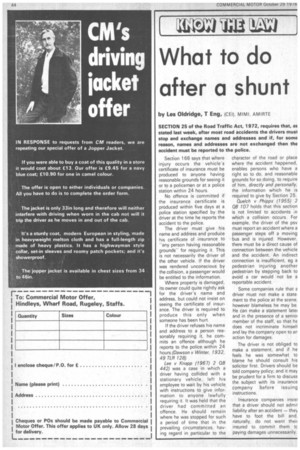What to do after a shunt
Page 66

If you've noticed an error in this article please click here to report it so we can fix it.
by Les Oldridge, T Eng, (CEO, MIMI, AMIRTE
SECTION 25 of the Road Traffic Act, 1972, requires that, as stated last week, after most road accidents the drivers must stop and exchange names and addresses and if, for some reason, names and addresses are not exchanged then the accident must be reported to the police.
Section 166 says that where injury occurs the vehicle's certificate of insurance must be produced to anyone having reasonable grounds for seeing it or to a policeman or at a police station within 24 hours.
No offence is committed if the insurance certificate is produced within five days at a police station specified by the driver at the time he reports the accident to the police.
The driver must give his name and address and produce his certificate of insurance to "any person having reasonable groundsfor requiring it. This is not necessarily the driver of the other vehicle. If the driver was rendered unconscious by the collision, a passenger would be entitled to the information.
Where property is damaged, its owner could quite rightly ask for the driver's name and address, but could not insist on seeing the certificate of insurance. The driver is required to produce this only when someone has been hurt.
If the driver refuses his name and address to a person reasonably requiring it, he commits an offence although he reports to the police within 24 hours (Dawson v Winter, 1932, 49 TLR 128).
Lee v Knapp (1967) 2 OB 442) was a case in which a driver having collided with a stationary vehicle, left his employee to wait by his vehicle_ with instructions to give information to anyone lawfully requiring it. It was held that the driver had committed an offence. He should remain where he was stopped for such a period of time that in the prevailing circumstances, having regard in particular to the character of the road or place where the accident happened, enables persons who have a right so to do, and reasonable grounds for so doing, to require of him, directly and personally, the information which he is required to give by Section 25.
Ouelch v Phipps (1955) 2 OB 107 holds that this section is not limited to accidents ;n which a collision occurs. For example, the driver of the psv must report an accident where a passenger steps off a moving • bus and is injured. However, there must be a direct cause of connection between the vehicle and the accident. An indirect connection is insufficient, eg a pedestrian injuring another pedestrian by stepping back to avoid a car would not be a reportable accident.
Some companies rule that a driver must not make a statement to the police at the scene, however blameless he may be. He Can make a statement later and in the presence of a senior member of the staff, so that he does not incriminate himsell and lay the company open to an action for damages.
The driver is not obliged to make a statement, and if he feels he was somewhat to blame he should consult his solicitor first. Drivers should be told company policy; and it may be prudent for a firm to discuss the subject with its insurance company before issuing instructions.
Insurance companies insist that a driver should not admit liability after an accident -they have to foot the bill and, naturally, do not want their insured to commit them tc paying damages unnecessarily.








































































































